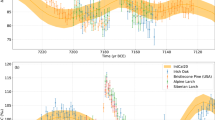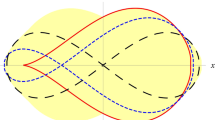Abstract
IN a letter from W. M. Goodall, which appeared in NATURE of June 10, p. 977, there is made one further step in the elucidation of the complex behaviour of Region F2 of the ionosphere, in that it is shown that there is a better correspondence between ionization and calcium flocculi figures for the central solar disk than there is between ionization and the usual sunspot numbers. From the determined relation between ionization and solar activity (as expressed by the calcium flocculi figures), it is possible to estimate the average seasonal variation of ionization over a number of years, the varying influence of solar activity being removed. Assuming, for example, that the solar activity had remained constant at a level expressed by the calcium flocculi character figure 3·0 throughout the period 1935–38 (actually, of course, it was gradually altering), the seasonal variation of the Region F2 critical frequency at Washington (lat. 39° N.) is as shown in curve A in the accompanying figure. The trend of such a curve confirms the observations of Appleton and Naismith1,2, who earlier found a similar variation in the northern hemisphere during sunspot minimum at both Slough and Tromso during the Polar Year 1932–33, and at Slough in succeeding years. The continuance of the radio work at Tromso by Harang3 has provided further confirmatory evidence, and we may now feel confident that a curve of this type represents fairly accurately the seasonal variation of noon critical frequency (and thus ionization) in the absence of marked ionospheric storms.
This is a preview of subscription content, access via your institution
Access options
Subscribe to this journal
Receive 51 print issues and online access
$199.00 per year
only $3.90 per issue
Buy this article
- Purchase on Springer Link
- Instant access to full article PDF
Prices may be subject to local taxes which are calculated during checkout
Similar content being viewed by others
References
Appleton, E. V., and Naismith, R., Proc. Roy. Soc., A, 150, 635 (1935).
Appleton, E. V., Naismith, R., and Ingram, L. J., Phil. Trans., A, 236, 191 (1937).
Harang, L., Terr. Mag., 42, 55 (1937); 43, 41 (1938); and 44, 15 (1939).
Appleton, E. V., and Ingram, L. J., NATURE, 136, 548 (1935).
Cortie, A. L., Mon. Hot. Roy. Astro. Soc., 73, 52 (1912).
Berkner, L. V., Wells, H. W., and Seaton, S. L., Terr. Mag., 41, 173 (1936); and Berkner, L. V., and Wells, H. W., 43, 15 (1938).
Author information
Authors and Affiliations
Rights and permissions
About this article
Cite this article
APPLETON, E. Characteristic Variation of Region F2 Ionization Throughout the Year. Nature 144, 151–152 (1939). https://doi.org/10.1038/144151a0
Issue Date:
DOI: https://doi.org/10.1038/144151a0
Comments
By submitting a comment you agree to abide by our Terms and Community Guidelines. If you find something abusive or that does not comply with our terms or guidelines please flag it as inappropriate.



